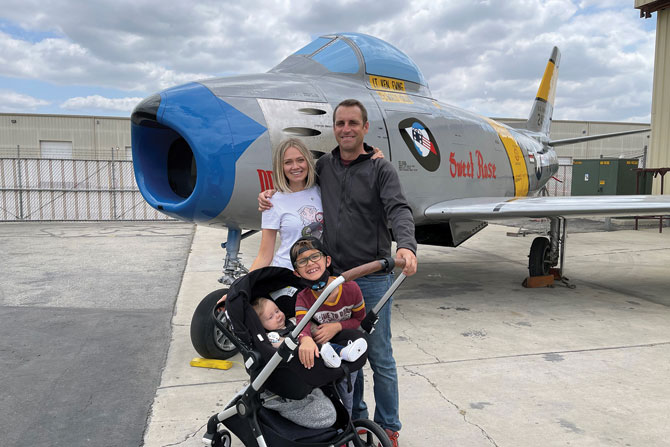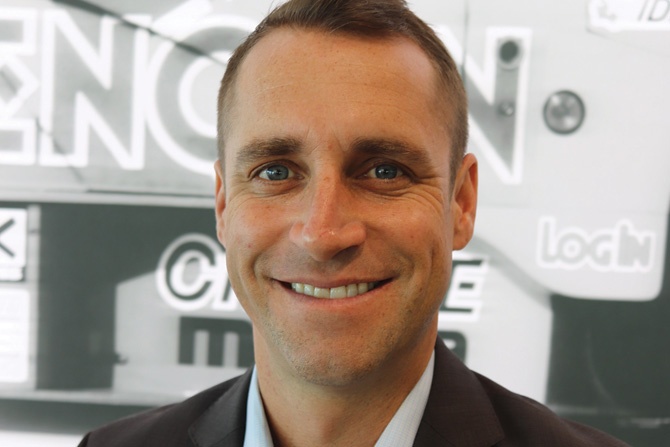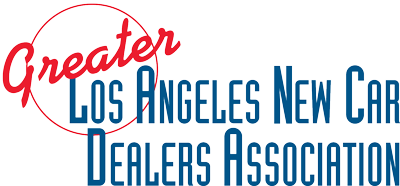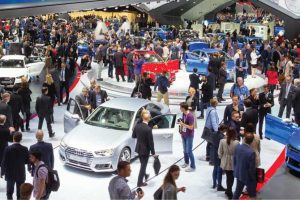You went to Emory University in Atlanta, Georgia. What did you study, and what life lessons did you learn there?
In 2001, I earned a B.A. in international studies. Emory is a great university, and I had great mentors. I was far from home, came into my own, and developed my individuality.
I was also a golf team member for four years, and I learned the most on the golf course. In addition to the desire it gave me to be better and work hard for what I wanted to achieve, golf also opened doors.
You are a third-generation dealer, but you didn’t want to go into the family business after college. Why did you change your mind?
As I grew up, I saw various aspects of what was then, and is now, rapidly changing the business. In 1995, for example, the internet side of the dealership business was just starting. During high school and college, I worked at a dealership each summer. As a result, I worked in various aspects of our business, such as stocking parts, being a parts driver, and being involved with the internet’s infancy as part of the retail suite business.
After college, though, I wanted to go outside and do something different. There are a couple of reasons for that. First, I wasn’t pressured to be a dealer, and second, I wanted to make my own name.
I worked for Bank of America after graduation. Bank of America is a massive Fortune 500 company, so my job there was a great opportunity, but I also saw what I was losing by leaving the auto industry. At the dealership, I can directly impact the lives of the 750 associates we have, and I can see how my decisions quickly affect my business. Also, I realized that I wanted the family business to continue as a family business. Not only had the dealerships been an important part of my life, I knew that good family business dealerships treat their associates like family members. That tradition is worth continuing.
What did your four years at Bank of America teach you?
My work taught me structure and that you could ask somebody to help you out, no questions asked, whether they were many levels up or down. It didn’t matter that you were part of a large organization.
That attitude about helping has translated well into developing my management structure over the last seven or eight years, and it has become one of the reasons behind our success. People need to be able to get a helping hand no matter where they are in the organization, and nobody’s position makes them immune to helping anybody else.
Tell us about your grandfather, Richard Browning.
My grandfather started his career washing cars at an Oldsmobile store in Long Beach. He was a salesperson and worked his way up to eventually purchasing the store he worked at in 1960. Unfortunately, he passed away when I was 12 years old. I don’t have many memories about him, but he was a salesman who knew the car business, knew his employees and knew his numbers.
One of my first memories of him was his nickname. He was known in the neighborhood as Mr. Clean, and he believed in cleanliness and order. He would get up at 5 a.m. to clean his driveway and his neighbor’s driveway. I don’t wash driveways at 5 a.m., but we do believe in maintaining a great facility environment for our associates.

What about your father, Kent Browning?
My father is a CPA by training who came into the business at a difficult time in the 1970s. Doing business was tough because of factors such as the 1973 gas crisis and high interest rates. Despite those challenges, he really expanded our dealership footprint. In 1980, our family owned one of the first dealerships in the Cerritos Auto Square. He was and is a risk-taker, and he’s had a lot of business ventures. He was not afraid of taking a risk, which is often a big part of success. Although he tried on some things that didn’t work, he was right more than he was wrong, and most of those risks turned out really well for him. He focused on numbers, but he also hired people he trusted to work around him. When he wasn’t working, he coached baseball teams, played golf and was just dad.
Are either of your two children interested in becoming dealers, or is it too soon to tell?
It’s a little premature to see if they will follow me into the family business. I will encourage them to follow their dreams, but I will also show them what I do.
Alexander is almost eight, and he is already a car fanatic. He loves supercars and fancy cars, and he has a large car collection. He was born in the right family. I also have an eight-month-old son.
How many stores does the Browning Automotive Group have?
We have eight stores in Southern California. Three are in the Cerritos Auto Square and are in the GLANCDA footprint:
- Browning Mazda
- Cerritos Acura
- Cerritos Dodge Chrysler Jeep
We have four stores in the Victorville market:
- Valley-Hi Honda and Valley-Hi Toyota (since 2001)
- Valley-Hi Nissan (since 2004)
- Valley-Hi Kia (since 2010)
- In Norco, we have had a Browning Dodge Chrysler Jeep Ram (since 2010).
What’s the leadership structure within the Browning Automotive Group?
At the end of 2020, we had a transition in our business. My brother Peter is also in the business. I already owned a couple of our newer stores with him and a couple of our partners. We purchased a majority interest in the remaining six stores from our father, who retired from the day-to-day business and became the chair. However, he still has an advisory role.
Peter is the general manager of the Cerritos Acura store. I am the president and dealer principal. We are developing a new management structure right now, and when we are ready, we will transition to it.
Do you plan to expand?
That’s a difficult question because the market is expensive right now. We have been looking for opportunities that are mostly elsewhere in the country, but if we don’t find the right ones, we will grow our business with our eight stores.
Tell us about restructuring the dealership websites and digital marketing in 2007 and 2008.
When I decided to transition back to the dealership business in 2005, I worked for a dealership in northern California called Toyota Sunnyvale. Tom Price and Adam Sims were the store’s co-owners, and I saw how modern that dealership was. I took what I learned at Toyota Sunnyvale, came back to the family dealerships, and realized we were not cutting edge. We only had a little online advertising presence. I took a lot of what I learned at Toyota Sunnyvale and changed how we advertised and also how we handled online customers. We had outside vendors help with the website.
I am not a technical person, but I understood the process and knew that we needed to be spending money on digital marketing instead of other kinds of traditional marketing. As a result, our digital marketing dollars eventually went from zero to 90% of the marketing budget.
The transition was difficult for some of the managers. Digital marketing was not the way marketing had been done; we’d done traditional marketing forever. But we made a quick transition and kept going.
During the Great Recession, we may not have reacted quickly enough, but we pivoted very quickly during the shutdown recession
You helped keep the family Acura store open during the Great Recession. How did that experience help you when the pandemic shut down the U.S. economy in March 2020?
It taught me to make difficult decisions early. Spend money wisely, grow the business and grow your market share. When necessary, make decisions quickly and don’t pontificate. You can cut your way into staying afloat, but you can’t cut your way into a profit. It is hard to grow when you are making cuts all the time.
All dealers who were around in 2008-2009 learned these lessons. It’s important to operate a lean organization. That way, you can make quick decisions and deploy staff as necessary.
During the Great Recession, we may not have reacted quickly enough, but we pivoted very quickly during the shutdown recession. First, we decided to operate the stores per the stay-at-home orders, and we cut a lot of staff. It was the right decision at the time. Then, when we saw the pandemic might not be bad from a business perspective, we brought the majority of the staff back quickly and made sure they were comfortable. We were methodical in our advertising approaches, and we also made sure we had inventory that people were looking for. Since we rebounded very quickly, we were very successful last year and this year.
What are the big issues for California dealers in the next 5-10 years?
I have a thousand of them. The biggest issue that we deal with is wage-and-hour employment litigation and PAGA concerns. Dealing with the intricacies of California employment law is difficult and time-consuming. California is not super business-friendly, and it takes a lot of mental and physical energy to deal with that. There’s a divergence between California’s environmental needs and consumer needs. State leadership wants to be on the cutting edge of electrification and infrastructure, but consumers don’t want a pure-electric system yet. That divergence is going to be a significant challenge for the automotive industry going forward. California is having a tough time keeping household lights on. Although California’s leaders want all new sales to be pure electric by 2035, the infrastructure requirements to meet that goal are astronomical. The whole thing has become a really big challenge for us.
That said, electric vehicles fill the needs of a small but growing portion of the consumers out there. As a retailer, we are happy to sell whatever vehicles consumers want, and we are excited about new products in the market. Companies like Tesla are hard to talk about because they are not part of the franchise system. Tesla, in particular, is a worry among franchise dealers because Tesla is selling a lot of cars, but the hope is that the state will be a strong franchise protector. It’s going to be interesting to watch daily.
What are your goals as an incoming GLANCDA board member and director?
GLANCDA is very important. The south Los Angeles area used to have an association called the Southland Motor Car Dealers Association that was disbanded a couple of years ago. The South Los Angeles area retails 50,000-plus cars a year, and we carry 21 brands in the auto square. I want to give our area a voice in the association.
We also have an employee shortage. I want to help fill the gap in training future employees of dealerships. Cerritos College has a technological training center that can help accomplish that goal.
How will your past experiences help you?
I have been on many boards in the past. The board has a responsibility to promote the interests of all the members and employees who work for us. For example, we need to make sure we have properly trained technicians. We also need to work with legislative partners to educate them on the challenges of the dealership business and the challenges of being an employer in California.
Are you still interested in cycling? How many miles per week do you ride?
I rode this morning. In general, I ride 100-150 miles per week. It’s good for the body and mind, and I also enjoy the fellowship. I have a lot of good friends who cycle. We don’t have a lot of biking trails, but we have lots of bike lanes. I ride with a group whose goal is to keep everyone safe.
Do you have other hobbies? What do you do for fun?
I am still an avid golfer, but the most fun I have is spending time with my two boys and my fiancé, Yuliya (pronounced like Julia with a Y). She is a recent U.S. citizen of Russian descent. It took her almost nine years to become a citizen, and she worked really hard to be able to do it. We’ve been together for 3.5 years.
What about the rest of your family?
You already know about my brother Peter, but I have a younger sister with three children. She is a partner in a law firm in New York. I also have three half-sisters. My brother-in-law is the general manager of Mazda in Cerritos (he is the husband of one of my half-sisters). But other than my brother and my brother-in-law, that’s it.








